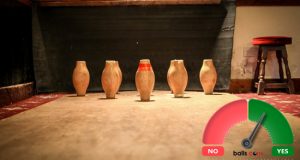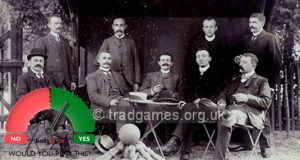Friend at Court, the US Tennis Association Handbook of Tennis Rules and Regulations, defines specifications for the weight, size, rebound and deformation for four types of tennis balls. Fast, medium, slow and high altitude types are defined.
APPENDIX I
THE BALL
For all measurements in Appendix I, SI units shall take precedence.
a. The ball shall have a uniform outer surface consisting of a fabric cover except for the Stage 3 (Red) foam ball. If there are any seams they shall be stitchless.
b. The ball shall conform to one of the types specified in the table immediately below or in the table under paragraph (d).
TABLE 1. TENNIS BALL SPECIFICATION
USTA Comment: The ITF, not the USTA, is responsible for the Rules of Tennis. Amendments to the Rules of Tennis are made through the procedures of the ITF. Rule 69 of the ITF controls the manner in which amendments may be made to the Rules of Tennis. Amendments to USTA Comments are made by the process described in USTA Regulation XIX.I.
|
TYPE 1 (FAST) |
TYPE 2 (MEDIUM)1 |
TYPE 3 (SLOW)2 |
HIGH ALTITUDE3 |
|
|
MASS (WEIGHT) |
56.0-59.4 grams (1.975-2.095 oz.) |
56.0-59.4 grams (1.975-2.095 oz.) |
56.0-59.4 grams (1.975-2.095 oz.) |
56.0-59.4 grams (1.975-2.095 oz.) |
|
SIZE |
6.54-6.86 cm (2.57-2.70 in.) |
6.54-6.86 cm (2.57-2.70 in.) |
7.00-7.30 cm (2.76-2.87 in.) |
6.54-6.86 cm (2.57-2.70 in.) |
|
REBOUND |
135-147 cm (53-58 in.) |
135-147 cm (53-58 in.) |
135-147 cm (53-58 in.) |
122-135 cm (48-53 in.) |
|
FORWARD DEFORMATION4 |
0.50-0.60 cm (0.197-0.236 in.) |
0.56-0.74 cm (0.220-0.291 in.) |
0.56-0.74 cm (0.220-0.291 in.) |
0.56-0.74 cm (0.220-0.291 in.) |
|
RETURN DEFORMATION4 |
0.67-0.91 cm (0.264-0.358 in.) |
0.80-1.08 cm (0.315-0.425 in.) |
0.80-1.08 cm (0.315-0.425 in.) |
0.80-1.08 cm (0.315-0.425 in.) |
|
COLOUR |
White or Yellow |
White or Yellow |
White or Yellow |
White or Yellow |
Notes:
- 1 This ball type may be pressurised or pressureless. The pressureless ball shall have an internal pressure that is no greater than 7 kPa (1 psi) and may be used for high altitude play above 1,219 m (4,000 feet) above sea level and shall have been acclimatised for 60 days or more at the altitude of the specific tournament.
- 2 This ball type is also recommended for high altitude play on any court surface type above 1,219 m (4,000 feet) above sea level.
- 3 This ball type is pressurised and is specified for high altitude play above 1,219 m (4,000 feet) above sea level only.
- 4 The deformation shall be the average of a single reading along each of three perpendicular axes. No two individual readings shall differ by more than .08 cm (.031 inches).
c. In addition, all ball types specified under paragraph (b) shall conform to the requirements for durability as shown in the following table:
Notes:
1 The largest permissible change in the specified properties resulting from the durability test described in the current edition of ITF Approved Tennis Balls & Classified Court Surfaces. The durability test uses laboratory equipment to simulate the effects of nine games of play.
d. Only the ball types specified in the table below can be used in 10 and under tennis competition:
|
MASS (WEIGHT) |
REBOUND |
FORWARD DEFORMATION |
RETURN DEFORMATION |
|
|
MAXIMUM CHANGE1 |
0.4 grams (0.014 oz.) |
4.0 cm (1.6 in.) |
0.08 cm (0.031 in.) |
0.10 cm (0.039 in.) |
|
STAGE 3 (RED) FOAM |
STAGE 3 (RED) STANDARD |
STAGE 2 (ORANGE) STANDARD |
STAGE 1 (GREEN) STANDARD |
|
|
MASS (WEIGHT) |
25.0-43.0 grams (0.882-1.517 oz.) |
36.0-49.0 grams (1.270-1.728 oz.) |
36.0-46.9 grams (1.270-1.654 oz.) |
47.0-51.5 grams (1.658-1.817 oz.) |
|
SIZE |
8.00-9.00 cm (3.15-3.54 in.) |
7.00-8.00 cm (2.76-3.15 in.) |
6.00-6.86 cm (2.36-2.70 in.) |
6.30-6.86 cm (2.48-2.70 in.) |
|
REBOUND |
85-105 cm (33-41 in.) |
90-105 cm (35-41 in.) |
105-120 cm (41-47 in.) |
120-135 cm (47-53 in.) |
|
FORWARD DEFORMATION1 |
1.40-1.65 cm (0.551-0.650 in.) |
0.80-1.05 cm (0.315-0.413 in.) |
||
|
COLOUR2 |
Any |
Red and Yellow, or Yellow with a Red dot |
Orange and Yellow, or Yellow with an Orange dot |
Yellow with a Green dot |
Notes:
1 The deformation shall be the average of a single reading along each of three perpendicular axes. There is no limit on the difference between individual forward deformation readings. There is no specification for return deformation.
2 All coloured dots shall be reasonable in size and placement.
e. All tests for rebound, mass, size, deformation and durability shall be made in accordance with the Regulations described in the current edition of ITF Approved Tennis Balls & Classified Court Surfaces.
References:
Friend at Court – https://www.nfhs.org/media/885689/2014fac_final2.pdf
Photo – aarugha.com/tennis-wallpaper-awesome.html
 Balls.com – Index of Balls used in Sporting Games and Events Sports balls specifications and rules. All levels of organized play.
Balls.com – Index of Balls used in Sporting Games and Events Sports balls specifications and rules. All levels of organized play.






